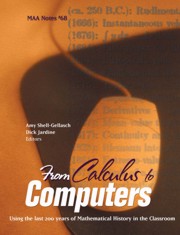Book contents
- Frontmatter
- Preface
- Contents
- Introduction
- I Algebra, Number Theory, Calculus, and Dynamical Systems
- II Geometry
- III Discrete Mathematics, Computer Science, Numerical Methods, Logic, and Statistics
- IV History of Mathematics and Pedagogy
- 16 Incorporating the Mathematical Achievements of Women and Minority Mathematicians into Classrooms
- 17 Mathematical Topics in an Undergraduate History of Science Course
- 18 Building a History of Mathematics Course from a Local Perspective
- 19 Protractors in the Classroom: An Historical Perspective
- 20 The Metric System Enters the American Classroom: 1790–1890
- 21 Some Wrinkles for a History of Mathematics Course
- 22 Teaching History of Mathematics Through Problems
- About the Authors
18 - Building a History of Mathematics Course from a Local Perspective
from IV - History of Mathematics and Pedagogy
- Frontmatter
- Preface
- Contents
- Introduction
- I Algebra, Number Theory, Calculus, and Dynamical Systems
- II Geometry
- III Discrete Mathematics, Computer Science, Numerical Methods, Logic, and Statistics
- IV History of Mathematics and Pedagogy
- 16 Incorporating the Mathematical Achievements of Women and Minority Mathematicians into Classrooms
- 17 Mathematical Topics in an Undergraduate History of Science Course
- 18 Building a History of Mathematics Course from a Local Perspective
- 19 Protractors in the Classroom: An Historical Perspective
- 20 The Metric System Enters the American Classroom: 1790–1890
- 21 Some Wrinkles for a History of Mathematics Course
- 22 Teaching History of Mathematics Through Problems
- About the Authors
Summary
Introduction
One of the challenges of developing a history of mathematics course is deciding what material to cover. The history of mathematics is far too broad a subject to cover in a year-long course, much less a one-semester course. Some options might be to focus on topics such as ancient mathematics, the history of the calculus, great moments in mathematics, great people in mathematics, and so forth. Any course developed must also take into account the audience and intent of the course. Are the students math majors or education majors? Will this be a general education course or a course for the mathematics major? These questions need to be answered before one can start to choose a focus for the course.
The United States Military Academy (USMA) at West Point, New York, does not have a standing history of mathematics course. So when I proposed a history of mathematics course to be offered only once, I wanted it to be unique. Given that the Academy has a long and important history, especially as the first engineering school in the nation (founded 1802), I wanted my students to get a feel for how mathematics has been an integral component of the Academy for over two hundred years. The course I devised is entitled The History of Mathematics from the West Point Perspective. This course uses the history of the USMA, the Department of Mathematical Sciences, and the mathematics curriculum to motivate the mathematical topics covered.
- Type
- Chapter
- Information
- From Calculus to ComputersUsing the Last 200 Years of Mathematics History in the Classroom, pp. 207 - 216Publisher: Mathematical Association of AmericaPrint publication year: 2005

